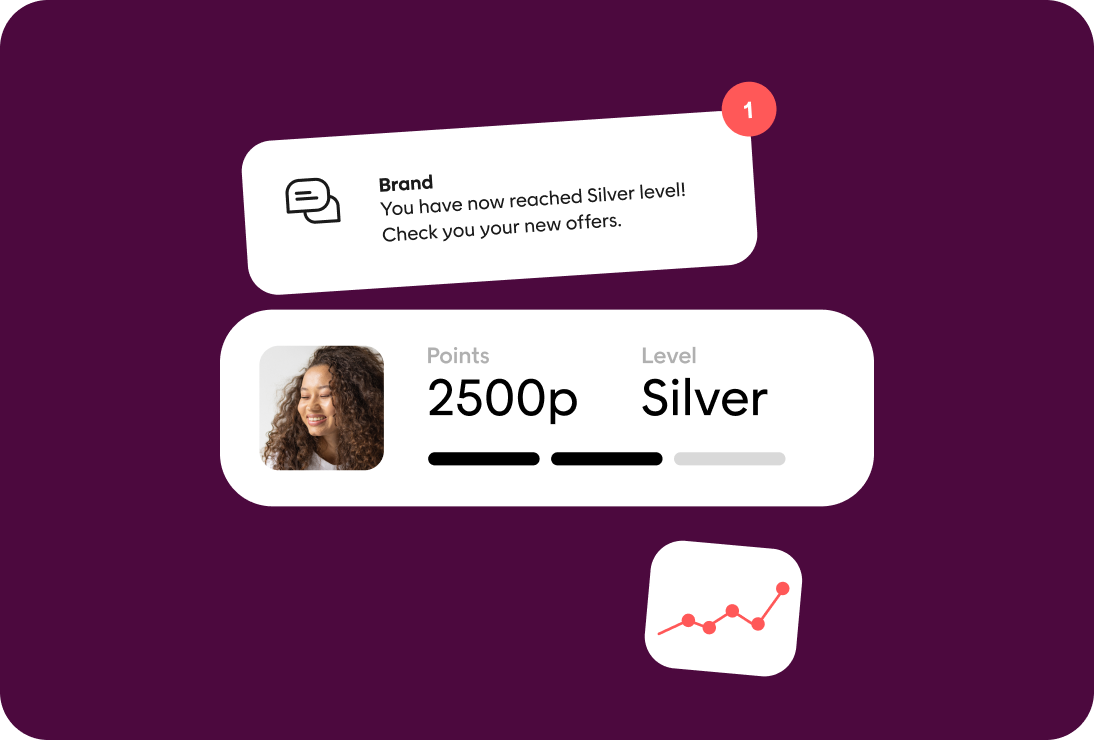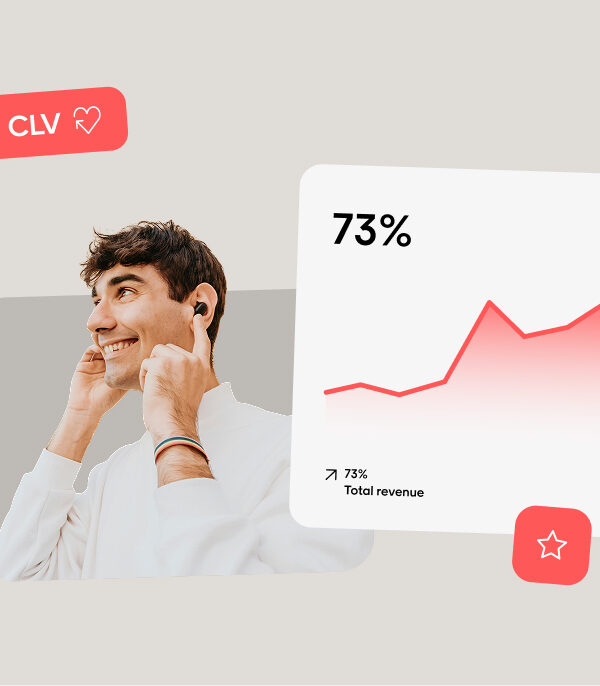TL;DR
- Loyalty program ROI = (incremental profit − program costs) ÷ program costs
- Prove causality, not correlation
- Focus on incremental revenue, margin, and lifetime value
- Track KPIs like activation, redemption, and repeat purchase
- Voyado connects your loyalty, data, and reporting to show what truly drives profit
Every retail leader wants proof that loyalty pays off.
Your business doesn’t just need more loyalty program members. It needs measurable, defensible profit.
Loyalty program ROI shows how much extra revenue and margin your loyalty efforts actually create. It connects loyalty program success to customer retention, purchase frequency, and higher customer lifetime value.
If your goal is to show clear financial impact from every loyalty effort, let’s start with what loyalty program ROI really means for your business and your customers.
What loyalty program ROI is (and what it is not)
Loyalty program ROI is often misunderstood. Many brands still equate it with total member revenue or broad engagement stats. But that’s not what investors or finance teams care about.
What it is:
The incremental profit directly attributable to your loyalty program, compared to a realistic baseline. In other words, what extra revenue and margin your program generates that wouldn’t exist without it.
What it’s not:
Total revenue from members, generic retention numbers, or vanity engagement metrics. Those show activity, not true business impact.
How to prove it:
- Use a control group of non-members or matched look-alike customers to compare performance
- Test pre- and post-program results to identify real uplift
- Apply holdouts or geo-level controls to confirm causality
These guardrails help you measure the loyalty program’s direct contribution to incremental revenue, customer retention, and higher customer lifetime value.
When you calculate loyalty program ROI this way, your business gains numbers that finance can trust and your teams can act on.
Next, let’s build a clear ROI formula your team can defend in every boardroom conversation.
The ROI formula retailers can defend in the boardroom
Every great loyalty program starts with belief, but belief doesn’t convince a CFO. Data does.
To secure future investment and prove the program’s success, your team needs a formula that ties every loyalty effort to real incremental revenue, margin, and net profit.
This is how you move from assumptions to clear business outcomes.
Here’s a simple, step-by-step model your business can rely on. It connects loyalty program ROI to customer behavior, higher customer lifetime value, and measurable profit.
Step 1: Incremental revenue
Start by defining your comparison. Measure your loyalty program members against a control group of similar non-members, or use a pre-post analysis with a matched look-alike cohort.
Formula:
Incremental Revenue = (Member Revenue − Baseline Revenue) over the same period.
This shows how much additional revenue your loyalty members generate beyond what non-members spend. It’s a direct view of your program’s financial impact, not just overall sales.
It’s essential to calculate and prove the ROI of your loyalty program so your team can make decisions based on measurable outcomes.
Understanding how to increase the ROI of your loyalty program gives you a practical foundation for improving profitability across channels.
Step 2: Incremental profit
Revenue alone doesn’t prove profitability. To calculate incremental profit, apply your gross margin and account for reward costs.
Formula:
Incremental Profit = Incremental Revenue × Gross Margin % − Reward Cost Impact
Reward Cost Impact includes discounts, redeemed loyalty points, and freebies at cost. These represent the real expenses tied to your program’s reward structure.
When calculated accurately, this number reflects the true value created by your loyalty members, showing both revenue uplift and sustainable margin growth.
Step 3: Total program cost
List every cost tied to running your loyalty program. Transparency here builds trust with finance teams and helps measure cost effectiveness over time.
Include:
- Tech and data: platform fees, integrations, analytics tools
- People: internal FTEs, external vendors, consultants
- Marketing: sign-up media, creative assets, communication costs
- Rewards and redemptions: COGS, partner fees, logistics
- Breakage and liability: accounting adjustments and points management
Strong customer loyalty data and insights from ROI in retail can help pinpoint which of these costs drive real value versus those that slow performance.
Step 4: ROI
Now, bring it all together.
Formula:
ROI = (Incremental Profit − Total Program Cost) ÷ Total Program Cost
This gives you a clear, defensible return on loyalty program investment that finance teams can validate.
You can also track secondary metrics such as Payback Period and Profit per Member to forecast future performance and support ongoing optimization.
If you use Voyado, unified profiles and cohort analysis make ROI tracking faster and more accurate. That way, your team gets one reliable source of truth for every calculation.
Next, let’s look at the data you need in place before you can calculate loyalty program ROI with confidence.
Data you need before you calculate
To accurately measure loyalty program ROI, you need to start with reliable customer data. Without it, even the smartest formula won’t hold up.
To measure and explain the ROI of loyalty programs, you need a clean, connected data foundation. Every transaction, reward, and touchpoint should flow into one consistent view.
Here’s what to have in place before running any ROI calculation:
- A clean member flag across POS, ecommerce, and app data
- Standard events for enroll, activate, earn, redeem, purchase, and return
- A margin source of truth for each category and reward
- Consent and identity resolution to prevent double counting
These inputs power your loyalty program ROI calculator and turn data into clarity for every stakeholder.
When deciding how to calculate ROI for loyalty programs, focus on metrics you can track across all systems. Each data stream should connect cleanly to your reporting layer so you can see exactly how loyalty activity drives profit.
Reliable, unified data helps you measure the ROI on loyalty programs and pinpoint where to improve performance. It also links customer loyalty programs and social media ROI, showing how engagement translates into real revenue.
This is how you move from raw data to a foundation that’s clear, credible, and defensible.
Voyado brings everything together in one consistent schema. With a single customer view, your team can track ROI loyalty program metrics confidently and strengthen loyalty and retention strategies that grow profit and trust.
Next, let’s look at how to attribute that value in a way that finance will back.
Primary: Cohort-based incrementality
Why it matters:
Cohort-based attribution separates perception from proof. It shows how loyalty members behave compared to existing customers who aren’t enrolled, helping you isolate the real drivers of growth and customer satisfaction.
How to execute:
- Create matched groups of loyalty program members and non-members.
- Track key metrics such as purchase frequency, average order value, and customer acquisition cost.
- Compare these cohorts over the same period to reveal true incremental revenue and margin impact.
What to expect when done right:
You’ll see the direct financial lift your loyalty program creates. This method highlights your most loyal customers, identifies which loyalty program costs deliver the most value, and validates your loyalty program ROI calculation as accurate and defensible.
Secondary: Journey-level attribution
Why it matters:
Understanding the full customer journey shows how your loyalty channels work together to drive engagement and profit. This layer of attribution gives you visibility into what influences repeat purchases and retention.
How to execute:
- Track performance across channels like email, SMS, push, and retail media.
- Use campaign holdouts or geo-level tests to measure each channel’s contribution.
- For always-on programs, rotate holdouts and report quarterly for consistent results.
What to expect when done right:
You’ll gain a clearer view of what motivates loyal customers to buy and which interactions drive positive loyalty program ROI.
Tracking detailed customer data across touchpoints will reveal how engagement activities translate into revenue, retention, and customer experience improvements.
Testing and validating attribution regularly builds trust with finance and confidence across teams.
It proves your loyalty strategy is grounded in numbers, not assumptions, and shows how successful loyalty programs contribute measurable, long-term growth.
Next, let’s explore which key metrics to track in your KPI tree so every part of the customer journey connects back to profitability.
From KPIs to ROI: what to measure and why it matters
Every number in your loyalty program tells a story. The goal is to connect those numbers so you can see how daily actions lead to measurable profit. This framework helps you turn your metrics into decisions that grow customer loyalty, margin, and retention.
1. Start with acquisition
This is where your program begins. Focus on how efficiently you attract new members.
- Opt-in rate: shows if your offer and message resonate
- Cost per enrollment: helps balance your customer acquisition cost
- Member mix: reveals whether you’re retaining existing customers or relying too heavily on new ones
Strong acquisition means your program has a clear value proposition that attracts quality members, not just quantity.
2. Track activation
Getting members to join is one thing. Getting them to engage is another.
- First earn and first redeem: show when a member becomes active
- Time-to-first-redeem: measures how long it takes to reach value
Quick activation builds customer engagement early and sets the stage for loyalty growth.
3. Measure engagement
This tells you whether your members see ongoing value in the program.
- Earners % and redeemers %: indicate active participation
- Redemption rate: shows if rewards are appealing
- Offer take-up: reflects how well campaigns match customer interests
These key metrics reveal how successful loyalty programs keep members motivated and satisfied over time.
4. Analyze behavioral lift
Behavioral lift shows how loyalty changes buying habits.
- Purchase frequency delta: measures repeat purchases
- Average order value (AOV) delta: indicates higher spending
- Category breadth: shows if loyal customers explore more of your range
- Return rate: signals product fit and customer satisfaction
Improvements here prove that your program is shaping better buying behavior, not just discount-driven sales.
5. Calculate value
Once you see behavior shift, measure the financial payoff.
- CLV uplift vs control: how much higher customer lifetime value is among members
- Margin per member and profit per member: connect loyalty to true return on investment ROI
These are the figures that show your loyalty program ROI is sustainable, not temporary.
6. Watch financial health
Keep an eye on the metrics that protect long-term profitability.
- Points issued vs redeemed
- Outstanding liability
- Breakage rate
Monitoring these ensures your loyalty program costs stay balanced and predictable. Voyado makes this easy by turning complex data into clear dashboards.
You can connect every KPI to a journey, segment, or offer, helping you see how each decision contributes to measurable results and a stronger customer experience.
Next, let’s look at a simple example to bring these calculations to life.
How to calculate loyalty program ROI in six months
Let’s turn the concept of loyalty program ROI into a clear, six-month model you can actually use. This framework helps your business measure progress, know when to expect results, and make adjustments along the way.
1. Set your baseline
Start by defining your six-month window. It’s long enough to reveal trends but short enough to stay actionable.
- Members: 500,000
- Control group: matched non-members with similar purchase patterns
Track both groups during the same period to compare outcomes. By the third month, you should see early shifts in purchase frequency or engagement from loyalty members.
2. Measure revenue lift
Midway through your window, review how your members perform against the control group.
- Member revenue per capita: $X
- Control revenue per capita: $Y
Formula: Incremental Revenue = (X − Y) × Members
This tells you how much additional revenue your loyalty program generated in six months. It’s the foundation of your loyalty program ROI calculation and highlights how customer behavior changes within a specific period.
3. Calculate incremental profit
At the end of the six months, turn that revenue into profit.
Formula: Incremental Profit = Incremental Revenue × Gross Margin % − Reward COGS Impact
Here’s what to include:
- Gross Margin % (G): your average margin over six months
- Reward COGS Impact (R): cost of redemptions, discounts, or freebies
When done correctly, this step reveals the real profit driven by your loyalty efforts and helps identify if margins are improving across your campaigns.
4. Account for total program cost
Next, calculate every cost linked to running your loyalty program during the same window.
Formula: Program Cost = Platform + People + Marketing + Reward Administration = C
Include platform fees, team costs, creative production, and partner fees. Tracking this quarterly or biannually helps manage cost-effectiveness and keep your loyalty program costs in check.
5. Find your ROI
Now pull it all together.
Formula: ROI = (Incremental Profit − C) ÷ C
This shows how much return your program delivers for every dollar invested. A positive result confirms your efforts are paying off, while a low or negative number points to where optimization is needed. Repeating this calculation every six months keeps your team aligned, informed, and ready to improve results with confidence.
Knowing exactly when and how to measure ROI gives your business a rhythm for proving progress and securing future investment.
Next, let’s explore the key levers to adjust when ROI isn’t meeting expectations.
Optimization levers to improve loyalty program success
Even the best loyalty programs hit plateaus. Maybe enrollments slow down, redemptions drop, or margins shrink.
When your loyalty program ROI starts slipping, focus on fixing one lever at a time instead of guessing across the board.
Here are the six most common challenges and how to turn them around.
1. When enrollments are weak
What’s happening:
Too much friction at checkout or unclear value makes customers skip sign-up.
What to do:
Simplify enrollment across channels. Use clear calls to action, cap incentives, and add gentle prompts at checkout or on product pages.
How Voyado helps:
Voyado’s enrollment triggers and progressive profiling tools make it easy to nudge sign-ups through email, SMS, or in-store POS without heavy setup.
2. When activation lags
What’s happening:
Members join but don’t engage, leaving your ROI stuck at the starting line.
What to do:
Build a short welcome journey with clear earn rules and a limited-time incentive for the first purchase. Set expiry dates to spark faster activity.How Voyado helps:
Voyado automates activation with ready-to-use journeys and expiry timers across email, SMS, and push, helping your teams move new members to action fast.
3. When members earn but don’t redeem
What’s happening:
Points pile up but members don’t see enough reason to use them.
What to do:
Lower redemption thresholds, introduce instant-win options, and test experiential rewards to make benefits feel more valuable.
How Voyado helps:
Voyado segments members by predicted redemption propensity so you can tailor offers that match real motivations.
4. When margin erodes
What’s happening:
Discounts and point payouts start cutting into profits.
What to do:
Add non-discount perks like early access, product bundles, and exclusive services. Adjust earn rules by category to protect high-margin areas.
How Voyado helps:
Voyado lets you manage earn multipliers and perks directly in-platform, balancing value for customers with healthier margins for your business.
5. When the repeat rate stalls
What’s happening:
Members stop returning as often, and purchase frequency flattens.
What to do:
Trigger replenishment reminders or next-best-action campaigns based on each member’s lifecycle stage. Keep communication relevant, not repetitive.
How Voyado helps:
Voyado uses predictive segments and product recommendations to keep members engaged with timely offers and messages that drive repeat purchases.
6. When liability grows
What’s happening:
Unredeemed points pile up, increasing your balance sheet liability.
What to do:
Remind members to use points nearing expiry, and adjust earn rules by season or category to balance issuance and redemption.
How Voyado helps:
Voyado gives you full visibility into earn and burn rates so you can manage liability proactively while still rewarding loyal customers.
If you’re exploring technology to support these improvements, the top loyalty program management software article highlights platforms designed to simplify optimization and reporting.
Next, we’ll look at how to align finance and compliance processes so your loyalty reporting stays watertight.
How Voyado proves and grows loyalty ROI
Loyalty should be measurable, repeatable, and easy to scale. That’s what Voyado was built for. It gives your teams the clarity to see which actions drive profit and the tools to keep improving results over time.
With Voyado, you can:
- Connect every channel. Unified profiles link store and online data, with consent and member flags built in for clean, compliant insights.
- Measure real impact. Cohort analysis, holdouts, and campaign-level incrementality show how each loyalty effort drives revenue and retention.
- Manage reward economics. Points, tiers, and reward structures are handled centrally, helping you balance customer value with profitability. For example, Jack & Jones achieved a 33% higher average order value for members after optimizing their program with Voyado.
- Act on prediction, not reaction. Predictive segments identify high-ROI behaviors so you can engage the right members at the right time.
- Report with confidence. BI-ready exports give finance teams the visibility they need to validate performance and prove total revenue impact.
Voyado brings loyalty, marketing, and finance together in one place, making it easier to connect loyalty economics with real business growth.
Book a demo to see how Voyado can help your business prove and grow loyalty ROI.
FAQs
What is a good loyalty program ROI?
A good loyalty program ROI is typically between 2:1 and 4:1, meaning you earn two to four times what you spend. The exact number depends on your industry and program maturity.
Do I need a control group to calculate ROI?
Yes. A control group of non-members is essential to prove causality and avoid overstating results. It helps compare purchase frequency, spend, and margin accurately.
How do I handle points liability in ROI?
Treat unredeemed points as liabilities until used or expired. Regularly track issued, redeemed, and expired points to maintain accurate financial reporting.
What if my members already over-index, will ROI look inflated?
Yes. Existing high-value customers can inflate ROI. Use matched cohorts or holdout tests to separate program impact from pre-existing spending habits.
Can I measure social media’s impact on loyalty ROI?
Yes. Track traffic and conversions from social campaigns using UTM parameters and attribution tools. Learn more about the top loyalty program management software.









